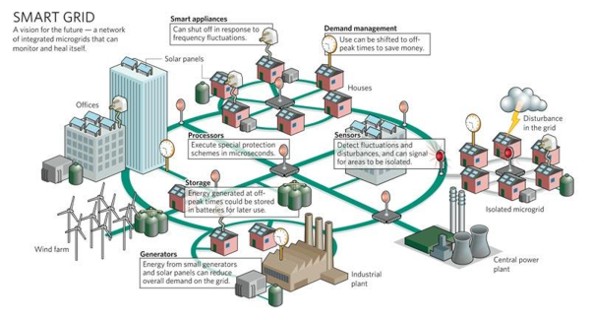 Smart grid model. Graphic courtesy of urbanecoist.com.
Smart grid model. Graphic courtesy of urbanecoist.com.NEW YORK- The creation of Long Island’s first integrated Smart Energy Corridor is being proposed by the Long Island Power Authority in collaboration with Stony Brook University and Farmingdale State College. Supporting the proposal are Gov. David A. Paterson and Rep. Steve Israel (D-N.Y.) .
LIPA will seek funding for the Smart Energy Corridor under the American Recovery and Reinvestment Act of 2009.
Locally, the initiative would assist all LIPA customers in monitoring and reducing energy usage as well as increasing reliability, according to a statement by the governor’s office.
In addition, LIPA will work with Farmingdale State to expand the college’s solar center to become a renewable and sustainable resource center for the demonstration of customer-owned renewable resources such as wind and solar. The college will also utilize the renewable energy center to expand certificate training programs for renewable resources for green technology entrepreneurs and industry employees.
On a much broader geographic perspective, Israel said, “The Smart Energy Corridor is a game-changing proposal that will continue to evolve the Route 110 Corridor, and make the corridor a prototype for the deployment of the latest energy technologies.
“The federal government recently committed $4.5 billion to the deployment of smart grid technology. This project is exactly what we should be investing in.”
The broad goal of the Smart Energy Corridor, according to Paterson’s office, is to upgrade Long Island’s energy infrastructure to a level that will accommodate cutting-edge technology, such as deploying smart grid technology along the Route 110 Corridor to enhance operational intelligence and connectivity.
The governor’s office further explained that “the Smart Energy Corridor would run along the 110 Corridor, the Long Island business community’s ‘Main Street, from Route 109 in Babylon to the Long Island Expressway in Huntington. The initiative would focus all of Long Island’s key energy related technology resources into advancing the development and implementation of a smart grid.”
Currently, the power grid is structured such that electricity flows from centralized power plants to local sub-stations via the grid’s transmission system, and then from those sub-stations through the grid’s distribution system to the end users.
. The governor’s office believes “this structure does not readily allow for the increased penetration of distributed generation that is located closer to where it is used. These clean energy technologies require an upgrade of the electric grid to a smart grid that allows for increased communication, control, monitoring, and diagnostic capabilities.”